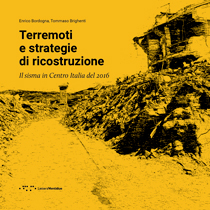
Rebuilding: where, how, when, for whom?
The
Italian architects’ debate on the topic of post-seismic
reconstruction for fifty years, if not more, has essentially stalled on
the question “where and how”. Every earthquake, and there
have been several in the last 50 years, is followed by an interminable
debate between those who believe it is necessary to reconstruct
“as it was, where it was” and those who – using as a
pretext an alleged compositional freedom and the need to express contemporaneity – believe
that we should instead rebuild elsewhere, or with other forms. On the
other hand, this debate is evidently entirely contained within the
architects’ category, which in our opinion seems to want the
repression of the real theme underlying the reconstruction of urban
fabrics, a theme that we can summarize in the other two questions that
the title proposes, i.e. “when and for who”. In short, we
must never forget that the earthquake is a tragedy, and that it leaves
behind ruins, dead and survivors without roots. The real theme of every
reconstruction project is that included in the headlines of the
newspapers the day after the earthquake in Irpinia which occurred on
November 23, 1980, quoting the commendable words of President Pertini,
“be fast”. With each earthquake a phase of emergency
begins, and it does not end until the urban tissues have been rebuilt
and the people have returned (if that is ever possible) to a normal
life. The reconstructions of historical fabrics destroyed by recent
earthquakes (Abruzzo 2009, Central Italy 2016) take more than ten
years, and as consequence when the reconstruction has finally taken
place, many people will have died in the meantime, and many others will
have been born elsewhere and will not recognize in that reconstruction
any identity value. In short, the reconstruction must begin
immediately, that is, as soon as the earthquake swarm has ended. And
this must be done with a medium-term planned strategy, which on the one
hand guarantees immediate temporary accommodation for the displaced
persons, but which in the meantime very quickly, within a maximum of 5
years, gives back to the inhabitants, in one way or another, their
homes, their workplaces, their streets, their public spaces and their
services (all of which are constitutional rights) thus allowing them to
return to normal a life, as much as possible.
The volume by Bordogna and Brighenti, with the preface by the great
master who unfortunately passed away recently and prematurely Giovanni
Carbonara, brings the architects’ attention back to the age-old
reconstruction problem, an attention that is never sufficient, and
presents us with numerous high-quality illustrations and various design
experimentats on this theme.
In the first part, the volume examines the various reconstruction
strategies that have been implemented in the past for the
reconstruction after an earthquake, accompanying them with important
author’s projects. Once again, we cannot fail to mention the
project by Gianfranco Caniggia and Francesca Sartogo,
Historical-critical research for the reconstruction and restoration of
the historic center of Venzone, 1977-1979 (Strappa, 2023) and the
Recovery project of the historic center of Teora, 1981-1983, by Giorgio
Grassi and Agostino Renna (Capozzi, 2011). But lets examine the dates,
1 year after the Friuli earthquake (1976) Caniggia and Sartogo were
already at work, 1 year after the Irpinia earthquake (1980), Grassi was
already planning. For the L’Aquila earthquake , which occurred in
2009, today after 14 years, construction sites have not yet started in
some smaller towns, but neither have the projects. In the second part
of the volume, various high-quality projects are presented which, at
different scales, propose the reconstruction of buildings, portions of
urban fabrics and entire inhabited centres, as in the case of Amatrice.
The volume collects a series of design experiments, conducted as
graduation thesis, where for Amatrice, Camerino and Norcia, the authors
explore the reconstruction of historical buildings with great care and
different strategies, and with formal results worthy of attention. It
is here that Bordogna Brighenti’s contribution shines, having
brought the attention of the faculty of architecture students to the
reconstruction project theme for several years, it has contributed
meaningfully to avoiding that widespread effect of psychological
repression that follows every earthquake, not only as and
understandable among the earthquake victims, but also among politicians
and above all – and it is even more serious – among
intellectuals.
The third part concludes the volume with an anthology of texts by
various authors on the reconstruction theme. The book as a whole can be
proposed as a reasoned guide to reconstruction, of great use both for
professionals and for students of the faculties of architecture and
engineering who find themselves drawing up post-seismic reconstruction
projects.
Alessandro Camiz
Book
Author: Enrico Bordogna,
Tommaso Brighenti
Title: Terremoti e
strategie di ricostruzione. Il sisma in Centro Italia 2016
Language: Italian
Publisher: Lettera
Ventidue Edizioni
Characteristics: 22x22
cm, 220 pages, paperback, color
ISBN: 978-88-6242-762-3
Year: 2022